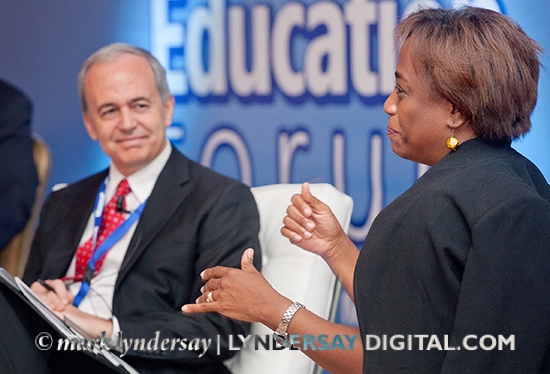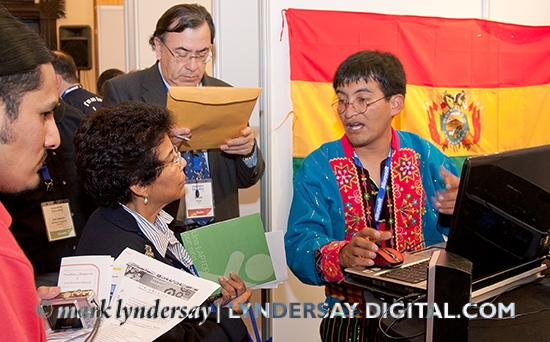Innovative Education Forum 2010
04/09/10 19:31 Filed in: Reporting
Latin America celebrates new education techniques
Story and photographs by Mark Lyndersay
Originally published in the Business Guardian, September 02, 2010.
A PDF facsimile of the story as published is downloadable here...

Panama City at dawn. Photography by Mark Lyndersay.
The Panama City that emerges from the clouds as an aircraft descends to land is a remarkable sight. The soaring skyscrapers form an imposing phalanx of concrete, steel and glass facing the ocean, reflecting sea and sky in a visual symphony of green and blue.
On the ground, rolling into the city, there’s another story. Many of these buildings are still under construction, the buzz of activity a hum in the air, and nestled into the flanks of this gleaming reconstruction of the capital of Panama are low income apartments that hover between tidy lower middle-class occupation and grimy ghettos.
The isthmus nation’s new government is all too keenly aware of this disparity and realises that if Panamanians are to work in those shiny new buildings as anything other than janitorial help, the country is going to have to make a quantum leap in education, raising all its citizens up with the same efficiency that they manage the water in the locks that underpin their economy.
Panama is a port nation, though that port happens to run right through the middle of the country. The system of canals and locks that links the Pacific and Atlantic oceans allows ships to avoid sailing all the way around South America remains one of the worlds engineering marvels.
The 96-year-old Panama Canal was ceded to the government of Panama in 1999 and the nation almost immediately saw a surge in income from an honorarium of US$10 million to the underpinnings of a fast growing economy.
Panama will expand the canal with two additional systems of locks that will expand access widths for ships from the existing Panamax sizing, the long standing designation for vessels that exactly fit the width and depth of the canal as it exists today.
Like Trinidad and Tobago, Panama is a nation with the blessing of a natural resource that makes it remarkably wealthy for its size. It’s an asset that was richly exploited by a more capable foreign power for most of its existence and now that it’s in local hands, the challenge now is leveraging it to change the nation.
Of Panama’s four million inhabitants, half live and work in the Canal Zone, a narrow strip of the country on either side of the canal.
At last week’s Innovative Education Forum (IEF) in Panama, Minister of Education Lucy Molinar made it clear that technology would be key to making that difference in the quality and scope of education available to all Panamanians.
Molinar’s enthusiasm for change has some opposition in the local teaching community, but the former journalist is adamant about pushing for the reforms.
“There is no one and no job more important than the teacher,” Molinar declared at the opening keynote of the forum. “We must take off the straitjackets that we’ve been wearing for all these years.”
In the weeks prior to the forum, 276 master teachers in Panama were trained in sessions facilitated by Microsoft, who are the hosts and sponsors of the IEF. These teachers will form the nucleus of a peer-coaching system which will allow two to three teachers from each school in the country, identified on the basis of their aptitude for technology, to work with Microsoft on achieving the Panamanian Education Minister’s goal of training the country’s 40,000 teachers over the next three years.
Panama will also be removing import tariffs on computer equipment imported by educational institutions, but as Molinar notes, “Technology cannot be purchased until teachers are trained.”
What will the Panamanian educators be teaching and learning? They are working with assets from Microsoft’s Partners in Learning programme, which has been formulated in alignment with the project goals that Unesco has set for 2015. Those alignments were formalised at an ICT in Education conference in Brasilia in April.
The workshops and coaching emphasise critical thinking and decision making for teachers working with new education models.
As Mireya Gussinye, one of the winning teachers in the 2009 IEF competition put it, “We have 21st century kids and we must begin to speak their language.”
These technology based teaching methods are meant to empower teachers to create their own unique classroom tools, and these creations were the centrepiece of the IEF, which saw more than a hundred teachers from 20 Latin American countries arrive in Panama to present a total of 55 projects to teacher evaluators.
Whatever one might think of Microsoft taking such a powerful leveraging role in the education future of the world through its efforts, there was no denying the excitement and enthusiasm of the participants as they set up their booths for evaluation and the inventiveness of the projects they displayed.
Twelve winners were selected by judges to move forward to the finals of the Worldwide Innovative Education Forum in Cape Town South Africa at the end of October 2010.
How Microsoft works to leverage education.

Teachers and evaluators at the opening keynote of the Innovative Education Forum in Panama. Photography by Mark Lyndersay
“We believe that despite the questioning of the teacher’s role in an age of technology that teachers are the most important vector of transformation in education,” said Guillermo Almada, Microsoft’s Public Sector Director for Latin America.
The company’s engagements in different countries vary according to what kind of help countries request. Argentina, with a population of 40 million and free public education to the tertiary level put 300,000 computers in its school system and will add another 300,000 in short order.
In Chile, Microsoft is working with the Government on curriculum development. In Puerto Rico, an extensive deployment of Live @ Edu is in progress.
The company is particularly proud of the work done with Medellin Digital in Colombia and the tiny province of San Luis in Argentina.
The Mayor of the province set out three years ago to blanket his constituency with WiFi and WiMax connections and to place a computer in schools for each child.
“When he decided on the project,” said Erika Twani, Microsoft’s Education Industry Lead for Multi-Country Americas, “he didn’t know that within three years, crime and school dropout rates would begin to decline. He describes it as the most impactful thing he’s done in office.”
 Twani oversees dozens of such projects and notes that all successful projects begin with the will to begin, to “do it.”
Twani oversees dozens of such projects and notes that all successful projects begin with the will to begin, to “do it.”
Microsoft is well aware of the People’s Partnership Government’s enthusiasm for technology and the ground breaking plan to deploy more than 20,000 portable computers in school in a matter of weeks.
“We really appreciate the fact that the Government has decided to just do it,” Twani said.
“Once the project begins, the ecosystem to support it springs up around it. Trinidad and Tobago will see a transformation within one year and hopefully, the Government won’t stop there.”
“Doing it is the first step; the next is to have a clear vision of where the country will be in five years. That vision for the long term must come from consultation with citizens, who must have a sense of responsibility and ownership of the decisions that are made.”
Microsoft has signed a Partners in Learning agreement with Trinidad and Tobago’s Ministry of Education and facilitated an education workshop in June this year.
There’s a lot more that can be done, but Microsoft emphasises that while it makes these services available it doesn’t push governments to become learning partners.
“We are willing to share our experience with any nation that calls,” said Guillermo Almada.
Microsoft has committed US$500 million to its Partners in Learning programme which the company formulated in 2003 and launched in 2004. The first phase ran for four years, and the project is currently midway through its second phase.
 The IEF is one of several summits and peer evaluations that Microsoft sponsors to bring teachers together competitively and collaboratively in the pursuit of bringing technology to education.
The IEF is one of several summits and peer evaluations that Microsoft sponsors to bring teachers together competitively and collaboratively in the pursuit of bringing technology to education.
Microsoft’s Worldwide Education Director, Kristen Hamilton noted at the keynote session of the forum that “Students are more technologically adept. Eighty-four percent of them are using social networks, and industrial revolution era learning systems don’t work anymore.”
The technology company leverages its existing technology products for education use (there’s education focused add-ins for Office), but it’s been working on new products for use in the classroom. Hamilton demonstrated crowd sourcing capabilities to Bing global maps which added user generated photographs to a collection of Microsoft generated panoramic photos and historical images at landmark locations.
Mouse Mischief, software that works with Powerpoint, allows teachers to create interactive presentations for classrooms that allow up to 50 students to use separate input mice simultaneously on a single computer and screen.
The Live @ Edu programme puts the crown jewels of Microsoft’s cloud-based collaboration tools at the disposal of any education institution, allowing any school to have access to enterprise class networking and file sharing products.
Microsoft uses these technologies to enable sharing of outstanding software generated from their global education initiatives among participating schools and teachers.
Microsoft’s vision statement for education.

Guillermo Almada, Microsoft's Public Sector Director for Latin America and Panama’s Minister of Education Lucy Molinar during the opening Keynote of the Innovative Education Forum.
An excellent education is a basic right and a social imperative.
Technology can accelerate insight and impact.
Effective immersive learning experiences inspire improved outcomes.
Communities of committed, collaborative participants are essential to advancing education.
Where was Trinidad and Tobago?

Grover Adán Tapia of Bolivia demonstrates his third place winning entry in the Content category, Learning Chemistry with Microsoft Office.
The competition to participate in the Innovative Education Forum is significant. In Latin America alone, competition on the national level resulted in more than 2,000 entries, from which 56 were chosen for the regional competition in Panama. The twelve winners of this regional competition move forward to the global finals in Capetown, South Africa at the end of October.
Despite the presence of the Trinidad and Tobago flag on the printed materials for the forum, there was no presence from this country beyond this reporter. The Ministry of Education offered three names for the competition, but the selected teacher was not released by the Ministry for the trip.
The top eight winners at the Latin American semi-finals won a previously unannounced touch-sensitive digital Smartboard for their schools.
Links
ITL Research (studies into the use of IT in education)
San Luis Digital
Medellin Digital on Flickr
Story and photographs by Mark Lyndersay
Originally published in the Business Guardian, September 02, 2010.
A PDF facsimile of the story as published is downloadable here...

Panama City at dawn. Photography by Mark Lyndersay.
The Panama City that emerges from the clouds as an aircraft descends to land is a remarkable sight. The soaring skyscrapers form an imposing phalanx of concrete, steel and glass facing the ocean, reflecting sea and sky in a visual symphony of green and blue.
On the ground, rolling into the city, there’s another story. Many of these buildings are still under construction, the buzz of activity a hum in the air, and nestled into the flanks of this gleaming reconstruction of the capital of Panama are low income apartments that hover between tidy lower middle-class occupation and grimy ghettos.
The isthmus nation’s new government is all too keenly aware of this disparity and realises that if Panamanians are to work in those shiny new buildings as anything other than janitorial help, the country is going to have to make a quantum leap in education, raising all its citizens up with the same efficiency that they manage the water in the locks that underpin their economy.
Panama is a port nation, though that port happens to run right through the middle of the country. The system of canals and locks that links the Pacific and Atlantic oceans allows ships to avoid sailing all the way around South America remains one of the worlds engineering marvels.
The 96-year-old Panama Canal was ceded to the government of Panama in 1999 and the nation almost immediately saw a surge in income from an honorarium of US$10 million to the underpinnings of a fast growing economy.
Panama will expand the canal with two additional systems of locks that will expand access widths for ships from the existing Panamax sizing, the long standing designation for vessels that exactly fit the width and depth of the canal as it exists today.
Like Trinidad and Tobago, Panama is a nation with the blessing of a natural resource that makes it remarkably wealthy for its size. It’s an asset that was richly exploited by a more capable foreign power for most of its existence and now that it’s in local hands, the challenge now is leveraging it to change the nation.
Of Panama’s four million inhabitants, half live and work in the Canal Zone, a narrow strip of the country on either side of the canal.
At last week’s Innovative Education Forum (IEF) in Panama, Minister of Education Lucy Molinar made it clear that technology would be key to making that difference in the quality and scope of education available to all Panamanians.
Molinar’s enthusiasm for change has some opposition in the local teaching community, but the former journalist is adamant about pushing for the reforms.
“There is no one and no job more important than the teacher,” Molinar declared at the opening keynote of the forum. “We must take off the straitjackets that we’ve been wearing for all these years.”
In the weeks prior to the forum, 276 master teachers in Panama were trained in sessions facilitated by Microsoft, who are the hosts and sponsors of the IEF. These teachers will form the nucleus of a peer-coaching system which will allow two to three teachers from each school in the country, identified on the basis of their aptitude for technology, to work with Microsoft on achieving the Panamanian Education Minister’s goal of training the country’s 40,000 teachers over the next three years.
Panama will also be removing import tariffs on computer equipment imported by educational institutions, but as Molinar notes, “Technology cannot be purchased until teachers are trained.”
What will the Panamanian educators be teaching and learning? They are working with assets from Microsoft’s Partners in Learning programme, which has been formulated in alignment with the project goals that Unesco has set for 2015. Those alignments were formalised at an ICT in Education conference in Brasilia in April.
The workshops and coaching emphasise critical thinking and decision making for teachers working with new education models.
As Mireya Gussinye, one of the winning teachers in the 2009 IEF competition put it, “We have 21st century kids and we must begin to speak their language.”
These technology based teaching methods are meant to empower teachers to create their own unique classroom tools, and these creations were the centrepiece of the IEF, which saw more than a hundred teachers from 20 Latin American countries arrive in Panama to present a total of 55 projects to teacher evaluators.
Whatever one might think of Microsoft taking such a powerful leveraging role in the education future of the world through its efforts, there was no denying the excitement and enthusiasm of the participants as they set up their booths for evaluation and the inventiveness of the projects they displayed.
Twelve winners were selected by judges to move forward to the finals of the Worldwide Innovative Education Forum in Cape Town South Africa at the end of October 2010.
How Microsoft works to leverage education.

Teachers and evaluators at the opening keynote of the Innovative Education Forum in Panama. Photography by Mark Lyndersay
“We believe that despite the questioning of the teacher’s role in an age of technology that teachers are the most important vector of transformation in education,” said Guillermo Almada, Microsoft’s Public Sector Director for Latin America.
The company’s engagements in different countries vary according to what kind of help countries request. Argentina, with a population of 40 million and free public education to the tertiary level put 300,000 computers in its school system and will add another 300,000 in short order.
In Chile, Microsoft is working with the Government on curriculum development. In Puerto Rico, an extensive deployment of Live @ Edu is in progress.
The company is particularly proud of the work done with Medellin Digital in Colombia and the tiny province of San Luis in Argentina.
The Mayor of the province set out three years ago to blanket his constituency with WiFi and WiMax connections and to place a computer in schools for each child.
“When he decided on the project,” said Erika Twani, Microsoft’s Education Industry Lead for Multi-Country Americas, “he didn’t know that within three years, crime and school dropout rates would begin to decline. He describes it as the most impactful thing he’s done in office.”

Microsoft is well aware of the People’s Partnership Government’s enthusiasm for technology and the ground breaking plan to deploy more than 20,000 portable computers in school in a matter of weeks.
“We really appreciate the fact that the Government has decided to just do it,” Twani said.
“Once the project begins, the ecosystem to support it springs up around it. Trinidad and Tobago will see a transformation within one year and hopefully, the Government won’t stop there.”
“Doing it is the first step; the next is to have a clear vision of where the country will be in five years. That vision for the long term must come from consultation with citizens, who must have a sense of responsibility and ownership of the decisions that are made.”
Microsoft has signed a Partners in Learning agreement with Trinidad and Tobago’s Ministry of Education and facilitated an education workshop in June this year.
There’s a lot more that can be done, but Microsoft emphasises that while it makes these services available it doesn’t push governments to become learning partners.
“We are willing to share our experience with any nation that calls,” said Guillermo Almada.
Microsoft has committed US$500 million to its Partners in Learning programme which the company formulated in 2003 and launched in 2004. The first phase ran for four years, and the project is currently midway through its second phase.

Microsoft’s Worldwide Education Director, Kristen Hamilton noted at the keynote session of the forum that “Students are more technologically adept. Eighty-four percent of them are using social networks, and industrial revolution era learning systems don’t work anymore.”
The technology company leverages its existing technology products for education use (there’s education focused add-ins for Office), but it’s been working on new products for use in the classroom. Hamilton demonstrated crowd sourcing capabilities to Bing global maps which added user generated photographs to a collection of Microsoft generated panoramic photos and historical images at landmark locations.
Mouse Mischief, software that works with Powerpoint, allows teachers to create interactive presentations for classrooms that allow up to 50 students to use separate input mice simultaneously on a single computer and screen.
The Live @ Edu programme puts the crown jewels of Microsoft’s cloud-based collaboration tools at the disposal of any education institution, allowing any school to have access to enterprise class networking and file sharing products.
Microsoft uses these technologies to enable sharing of outstanding software generated from their global education initiatives among participating schools and teachers.
Microsoft’s vision statement for education.

Guillermo Almada, Microsoft's Public Sector Director for Latin America and Panama’s Minister of Education Lucy Molinar during the opening Keynote of the Innovative Education Forum.
An excellent education is a basic right and a social imperative.
Technology can accelerate insight and impact.
Effective immersive learning experiences inspire improved outcomes.
Communities of committed, collaborative participants are essential to advancing education.
Where was Trinidad and Tobago?

Grover Adán Tapia of Bolivia demonstrates his third place winning entry in the Content category, Learning Chemistry with Microsoft Office.
The competition to participate in the Innovative Education Forum is significant. In Latin America alone, competition on the national level resulted in more than 2,000 entries, from which 56 were chosen for the regional competition in Panama. The twelve winners of this regional competition move forward to the global finals in Capetown, South Africa at the end of October.
Despite the presence of the Trinidad and Tobago flag on the printed materials for the forum, there was no presence from this country beyond this reporter. The Ministry of Education offered three names for the competition, but the selected teacher was not released by the Ministry for the trip.
The top eight winners at the Latin American semi-finals won a previously unannounced touch-sensitive digital Smartboard for their schools.
Links
ITL Research (studies into the use of IT in education)
San Luis Digital
Medellin Digital on Flickr
blog comments powered by Disqus
